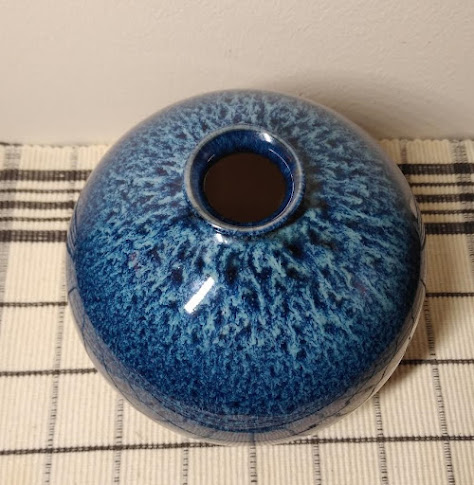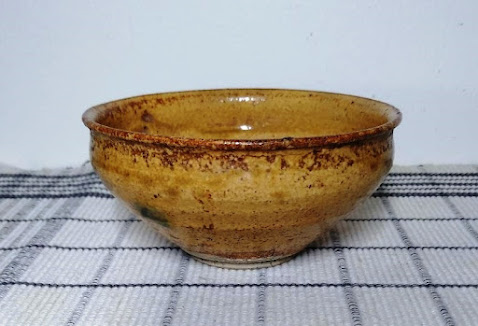158. Iga-ware vase, wood-fired, early
twentieth century
Iga-ware is a long-established tradition
of Japanese pottery made in what is now Mie Prefecture in central Japan, east
of the Kyoto-Osaka-Nara region. The seller dated this to the Meiji period.
Dark coarse clay with small, white embedded
pebbles; interior and upper part of exterior glazed in a bluish-gray ash glaze; other
colors from wood firing. Weight: 2190 g (5 lb). Widths: mouth, 5.7 cm (2-1/4
in); lip, 8.8 cm (3-1/2 in); neck, 7.5 cm (3 in); maximum, 12.5 cm (5 in);
base, 11.3 cm (4-1/2 in). Height: 28 cm (11 in).
This sits directly on the base. The
interior of the base is hollowed out in a concavity to the depth of about 2 cm
(3/4 in). Above the base the walls curve outward in a convex line to the
maximum width, which is 2.5 cm (1 in) above the base, and then curve inward to
the minimum width of 10 cm (4 in), which begins 7 cm (2-3/4 in) above the base.
The walls rise more or a less in a straight line to the base of the ear
lugs 18.3 cm (7-1/4 in) above the base,
before widening slightly to 11.3 cm (4-1/2 in) at the shoulders, which begin
24.5 cm (9-3/4 in) above the base. At the shoulders, the walls turn abruptly
inward in a straight line to the neck, which consists of two parts. The lower
part is 7.5 cm (3 in ) in diameter and about 1 cm (3/8 in) high. The upper part
is 8.8 cm (3-1/2 in) wide and about 1.5 cm (5/8 in) high. The upper part of the
neck is squarish in shape, as is the mouth. The ear lugs were formed from rectangles
roughly 2.5 cm (1 in) wide and 10 cm (4 in) long, folded down at the top and
attached at the shoulders and then curved outward and down to reconnect with
the body of the pot about 6.8 cm (2-3/4 in) down.
The exterior
of the pot was not smoothed and shows throw marks along the entire length. A
spatula was used to scrape six long vertical gouges on the walls of the pot,
two on each face, and one under each ear lug.
The ear lugs were attached in a deliberately haphazard manner. They are
not exactly opposite each other; nor are they precisely vertical. The surface
of the pot is rough and pitted. As is
characteristic of Iga ware, small white pebbles were embedded in the surface of
the clay at random points.
The interior and the upper part of the
exterior were glazed in what looks like an ash glaze, bluish gray in color, with
a fair amount of carbon capture. The glaze ran down the exterior in a series of
long drips. This was wood-fired, and the other colors on the exterior, which
range from a light reddish tan to a sooty dark brown, result from the
interactions in the kiln among heat, smoke, and clay.
A blunt statement of what can be done
with clay. The molding is deceptive—seemingly careless, but not carefree or
whimsical in the way that some Oribe is. The pot is heavy and coarse as a principled
statement of an aesthetic. Skill and
experience went into the making of this. It only looks rough-hewn. It is the
result of a highly conscious and well-conceived “ineptitude.”
This is a heavy pot to lift. It’s very
solid and earthbound (in many senses). I wouldn’t say that it’s a pleasure to
hold—it feels dusty and dirty, rough, coarse. It shifts abruptly from round to
squarish shapes. It’s unbalanced. The curves of the gashes along the walls
impart motion to the vase and make it look as though it leans to one side (this
is an optical illusion—the body is symmetrical). The pot appears to be divided
into ill-sorted segments, put together in a slapdash fashion. It is, as current
jargon has it, full of wabisabi.
This came with a box, quite old to judge
from its appearance. The characters on the lid are, on the upper right 伊賀 耳付 (Iga; mimitsuki),
Iga[-ware], vase with attached ears. The column to the left of this appears to read 花生 (hanasei), “flower life,”
another term for a vase. The characters were also written on a strip
of paper glued to the side of the box.
Written on the bottom of the box in ink are the small characters 日.山. (in Japan, these would be read right to left). There are dots after each
character, presumably to indicate these are separate components and not one
word. The characters are read hi or nichi (“sun/day/Japan”) and
yama or san (“mountain”). There is a small circle O on a separate line beneath the characters.
Purchased from Treasures of Old Times in
Bangkok, November 2021.



















































